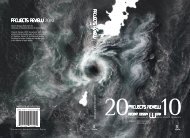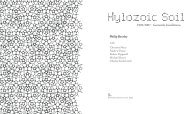The Inner Studio - Riverside Architectural Press
The Inner Studio - Riverside Architectural Press
The Inner Studio - Riverside Architectural Press
Create successful ePaper yourself
Turn your PDF publications into a flip-book with our unique Google optimized e-Paper software.
THE INNER STUDIO<br />
world and they automatically “see” their answers. As they begin to<br />
describe their responses, they are actually describing the images<br />
they have “seen” or in some way “sensed” internally. Designers<br />
don’t do this because they are taught to, but because this is how our<br />
minds work. Forming images is a crucial mechanism in the process<br />
of thinking and people who are visually inclined are more likely to<br />
“see” their thinking–albeit unconsciously.<br />
As we shall see, visualization is not just the capacity to see<br />
objects in the mind’s eye–it may include hearing, sensing, touching,<br />
or tasting, or any combination of these vehicles of perception. <strong>The</strong><br />
key is to get to know which of these avenues works best for you.<br />
In the inner studio, visualization means learning to consciously<br />
work with images as they are created in the mind’s eye. We want to<br />
become skillful at not only “picturing” the places and things we are<br />
trying to make, but also more practiced at summoning the subtle<br />
levels of feeling that are responsible for our own internal image<br />
making. We want to bring the rich and complex world of the imagination<br />
into the making of our world.<br />
Drawing or modeling visualized images means capturing the<br />
essence of the image–adding details and all manner of elaboration<br />
make up the content of the development phase of design. <strong>The</strong><br />
drawing has to carry enough information to allow the image to<br />
unfold and to allow us access back to the visualization. <strong>The</strong> act of<br />
drawing or modeling is an essential element of the design process<br />
because it connects us with the process of materializing the image.<br />
I will discuss this further after exploring the inner world of imagination<br />
first through visualization and then through active<br />
imagination.<br />
<strong>The</strong> Experience of Visualization<br />
When we observe an image in the mind’s eye, we see the images<br />
within; our eyes don’t have to be open. What distinguishes visualization<br />
from active imagination is that visualization works when we<br />
know what we want to visualize and directs the unconscious to<br />
produce the image. We already have an image, perhaps a memory,<br />
texture, or condition, and want to put our sense of what is best to<br />
the test.<br />
110





